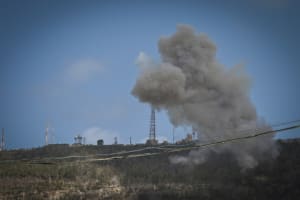Northern Israel under threat: Hezbollah's menacing drone force raises concerns
Lebanese terror group killed and wounded numerous Israelis using drone attacks

Over the past several years, the use of drones in armed conflicts such as the war between Armenia and Azerbaijan and the Russia-Ukraine War, as well as by several Iranian proxy militias, has revolutionized battlefield tactics around the world.
Ironically, one of the countries that pioneered the military use of unmanned aerial vehicles (UAVs) in the past, Israel, has now been suffering daily drone attacks on at least five fronts for over half a year.
Hamas used cheap, small commercial drones to great effect during its surprise attack on October 7, even causing the IDF to hurriedly install metal cages over its tanks to prevent drones from dropping explosives on them.
IDF tanks with cope cages just as it prepares for a possible ground invasion of Gaza. pic.twitter.com/YejTfge2WI
— Frontalforce 🇮🇳 (@FrontalForce) October 16, 2023
Apart from Hamas’ use of drones during the ground fighting in the Gaza Strip, the main drone threat facing Israel has since come from Iran’s so-called 'Axis of Resistance.'
This development culminated in the largest drone attack in history when Iran launched 185 drones in several swarms against Israel, all of which were intercepted before reaching the Jewish state.
While Iran-backed militias in Syria and Iraq, and even the Yemeni Houthi rebels, have launched drones against Israel once in a while, the Lebanese terror militia Hezbollah has raised the intensity of its drone attacks to the point of carrying out more than one drone attack per day during the month of April.

After launching its attacks on Israel last October, mainly using rockets and anti-tank missiles, the terror group has increasingly relied on drone attacks – killing and wounding numerous Israelis over the past few months.
Most of the drones produced by Western nations, like Israeli or U.S. drones, are designed for long-range missions and either gather intelligence or carry precise munitions that can be launched from the drone, which then returns to its base unharmed.
Contrary to this, most of Iran’s drones are meant to explode upon impact on the target and are, therefore, often called “suicide“ or kamikaze drones.
Because they are relatively simple and cheap to produce, in effect, they function as low-cost cruise missiles, delivering relatively large warheads at high precision and low cost.

Lebanese terrorists have been the main benefactors of their Iranian sponsors’ armament program over the past decades, which has increased in pace after the Syrian Civil War enabled Iran to strengthen its grip on the country, allowing it to facilitate larger and more frequent shipments through Syria.
Israel has worked tirelessly in an effort dubbed the “war between wars” to thwart the covert arms smuggling to Hezbollah, carried out by Iran’s Islamic Revolutionary Guard Corps (IRGC) through Iraq and Syria.
Nevertheless, it is estimated that Hezbollah managed to amass a huge arsenal of weapons, including some 150,000 rockets and missiles, as well as an estimated 2,000 drones of various types and ranges.
Most of these drones were imported from Iran, but more worryingly for Israel, Hezbollah also claims to have begun local assembly of Iranian-designed drones, as well as outright local production.
Hezbollah footage of their UAV attack on northern Israel (Nov 10). The drone model is the Mirsad-1, a copy of the HESA Ababil-2 made in Iran and supplied to proxies across the Middle East. 3 drones were intended for 3 targets around Yiftah, with only 1 reaching a target.… https://t.co/BiSsHRPsKP pic.twitter.com/NUnmI2C3oF
— Israel-Alma (@IsraelAlmaorg) November 10, 2023
Most of its drones are modeled on the Iranian ”Ababil,” which has been produced for several decades now. The oddly shaped aircraft features two short wings in front and larger wings in the back and has been spotted over the skies of Israel several times in the past months.
The drone’s simple design makes it easy to assemble locally. While modern radars can detect it, its small radar cross signature and cheap production cost have made it one of the most successful Iranian exports, being used by terrorists from Yemen and Iraq to Pakistan.
The Ababil drone has a range of 120 km (74 miles), can reach speeds of 370 km (230 miles) per hour at a maximum altitude of up to 3,000 meters (over 9,800 feet), and can deliver up to 40 kg (88 lb) of explosives.
It is a typical ”suicide” drone, meant to precisely slam into a target and explode on impact. This is what happened on April 16 and 17 in the Israeli towns of Beit Hillel and Arab al-Aramsheh, respectively.
In just two attacks, Hezbollah managed to kill one IDF soldier, and wounded 13 soldiers and 7 civilians with Ababil drone assaults, showcasing its precise intelligence and highlighting the effectiveness and danger of these weapons.
Footage circulating on social media shows a drone flying over the Galilee Panhandle, with initial reports saying it exploded in the Beit Hillel area. The IDF has not yet commented on the incident. pic.twitter.com/xeKURvg3vF
— Emanuel (Mannie) Fabian (@manniefabian) April 16, 2024
Another type of drone being used by Hezbollah is the delta-wing Shahed 136 drone, which is classified as ”loitering munition.” Once launched, it is in constant communication with the operator and can therefore ”loiter” over a target until the operator chooses the right moment to strike.
Hezbollah also possesses larger, more dangerous drones, as Israel revealed in 2023 when Defense Minister Yoav Gallant presented evidence of an airstrip specially built by Iran to help Hezbollah launch its drones against Israel.
The Israeli Air Force has since destroyed the runway but it is estimated that Hezbollah and Iran built several more drone launch posts of this kind.
As the Lebanese terror group has gradually been pushed back from the Israeli border, it has switched from mainly using anti-tank missiles, which have a relatively short range, to launching even more drones against Israel.
The number of its drone attacks jumped by a factor of 3.5 from February to March, according to the Alma Research Center, and doubled again in April. While they only made up 19% of Hezbollah attacks against Israel in April, drones were responsible for a much larger proportion of Israeli deaths and injuries.

The terror group combined many of its drone launches with rockets, mortar, or anti-tank missile fire to increase its chances of penetrating Israel’s vaunted aerial defense array.
Hezbollah also uses drones to gather intelligence or as decoys, probing the air defense’s responses to different scenarios to gain operational data.
In conclusion, drone warfare has become an increasingly central component of Hezbollah’s war against the Jewish State. Despite heavy aerial bombardment by the Israeli Air Force, the terrorists’ drone force doesn’t seem to have suffered any major harm.
Even if a diplomatic agreement pushes the terrorists further back from the border, Israel’s north is likely to remain under constant threat from Hezbollah’s drones for the foreseeable future.

Hanan Lischinsky has a Master’s degree in Middle East & Israel studies from Heidelberg University in Germany, where he spent part of his childhood and youth. He finished High School in Jerusalem and served in the IDF’s Intelligence Corps. Hanan and his wife live near Jerusalem, and he joined ALL ISRAEL NEWS in August 2023.
You might also like to read this:















